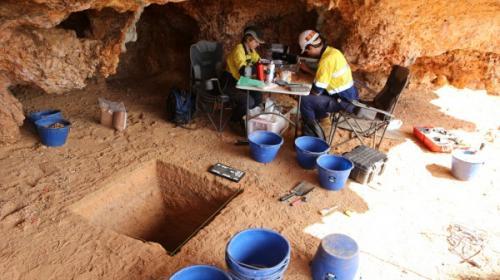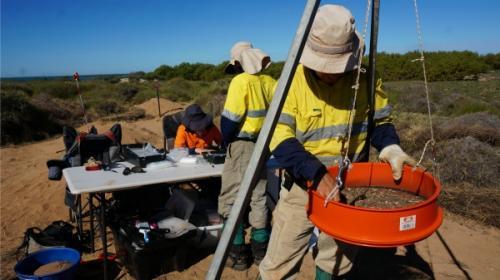Geoff Vivian / Science Network WA
Source - http://phys.org/news/2015-02-pilbara-debunk-timeline-ancient-tool.html

Excavations at the John Wayne Rockshelter, Barrow Island, July 2014. Credit: Peter Veth
Recent archaeological digs at Barrow Island and the Montebello Islands off the Pilbara coast have revealed a number of artefacts which have helped build a unique record of coastal habitation by early humans.
UWA archaeologist Peter Veth says edge-ground stone axes were made there earlier than had been thought, but that inhabitants were yet to fit points to spears.
He says his team did not discover mid-to-late Holocene (11,700 year ago) artefacts commonly found through mainland Australia such as mature ochres and formal seed-grinding stones.
However, flakes of stone show edge-ground axes were made at the site 15,000 years ago.
Prof Veth says this find will challenge conventional notions of when the technology occurred, as archaeologists had previously thought it confined to the continent's far north until 4,000 years ago.
They uncovered ornaments including a Baler Shell fragment decorated with cross-hatched incisions and drilled holes, and tusk shell beads within a unit dated to about 30,000 years ago.
He says they have also found traces of mangrove forests, shellfish remains and locally-extinct mammals.
These include burrowing bettongs (Bettongia lesueur), now restricted to more southern habitats, and nail-tailed wallabies (Onychogalea) now found in the NT and east Kimberley.
He says the islands were part of the Australian mainland until about 7,000 years ago with cave floor sediment analysis showing these islands were then abandoned.

An archaeological survey on Barrow Island in 2013. Credit: BIAP
He is excavating Barrow Island caves with archaeologist Tiina Manne, following earlier finds at the Montebellos, which they dated to 31,000 – 7,500 before present.
On Barrow Island, they located different land forms using 400 metre square quadrats.
"We looked at areas that had potential archaeological deposits, mainly in shelters and caves, and they are largely restricted to old Calcarenite headlands," he says.
They wet-sieved excavated material through 1mm mesh, which is fine enough to detect minute charcoal and other fragments for radiocarbon analysis.

Scientists using a sieve on Barrow Island. Credit: Alistair Paterson
While Barrow Island was not part of the coastline, Prof Veth says middens show it was a convenient place to prepare and eat seafoods which could be brought from the sea without spoiling.
He says the island was then a prominent outcrop with an extensive system of habitable caves, in which his team found remains of marine species including sea snails (Terebralia).
On what are now the Montebellos, inhabitants brought increasing numbers of mud crabs (S. serrata); and the snails T. palustris, T telescopium and T semistriata; as sea levels rose and shorelines became closer.